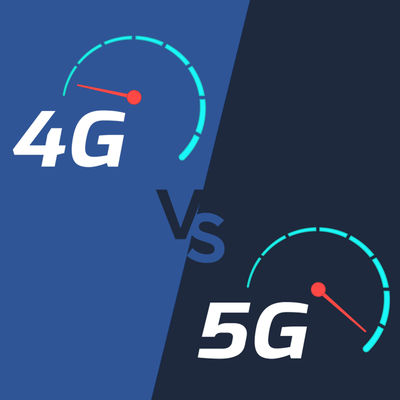Back to the Basics: What is the Difference Between 4G, LTE, and 5G?
Posted by Gordon Reed on 12th Nov 2025
Understanding the Generations of Wireless Technology
As mobile and IoT connectivity continues to evolve, the terms 4G, LTE, and 5G are often used interchangeably, even though they represent distinct stages in wireless network development. For anyone deploying routers, hotspots, or industrial IoT devices, understanding these differences is key to choosing the right hardware and antennas for reliable, high-performance communication.
A Quick Look Back: From 3G to 4G
The shift from 3G to 4G marked the transition from voice-centric networks to true broadband data systems. 3G enabled web access and email on mobile devices, but 4G was the first generation designed for high-speed, all-IP data transmission.
4G introduced higher data throughput, lower latency, and improved spectral efficiency, making streaming video, real-time navigation, and HD video calls practical. With typical download speeds exceeding 20 Mbps and peak performance up to 100 Mbps or more, 4G fundamentally changed how devices connect and share data.
LTE: The Bridge Between 4G and 5G
LTE, or Long Term Evolution, is not a separate generation; it’s the advanced standard that defined modern 4G. When LTE was first introduced, it fell slightly short of ITU’s official “4G” performance benchmarks, but successive improvements like LTE-Advanced (LTE-A) and LTE-A Pro met and exceeded those requirements.
LTE’s use of OFDM (Orthogonal Frequency Division Multiplexing) and MIMO (Multiple Input Multiple Output) revolutionized network efficiency. By dividing data streams across multiple subcarriers and antennas, LTE maximized spectral use and improved throughput.
Even today, LTE remains a critical backbone of global connectivity, especially for IoT and industrial networks that rely on proven stability, extensive coverage, and mature infrastructure.
Enter 5G: The New Era of Connectivity
5G represents the next leap forward, engineered for ultra-fast data speeds, minimal latency, and massive connection density. Unlike previous generations, 5G is designed to serve both consumer and industrial applications, from smartphones to autonomous systems and smart infrastructure.
Key Characteristics of 5G:
- Speed: Capable of exceeding 10 Gbps under optimal conditions.
- Latency: Reduced to under 10 milliseconds, enabling real-time responsiveness.
- Device Density: Supports millions of devices per square kilometer, ideal for IoT ecosystems.
- Frequency Spectrum: Operates across sub-6 GHz and mmWave (24–40+ GHz) bands.
- Architecture: Employs advanced technologies like beamforming, massive MIMO, network slicing, and edge computing for scalable, flexible deployments.
5G’s sub-6 GHz range provides wide coverage similar to LTE, while its mmWave spectrum delivers extremely high data rates over shorter distances, perfect for dense urban or private industrial networks.
Comparing 4G, LTE, and 5G
|
Feature |
4G / LTE |
5G |
|
Peak Speed |
Up to ~1 Gbps (LTE-A) |
10+ Gbps |
|
Latency |
30–50 ms |
<10 ms |
|
Frequency Range |
600 MHz–3.5 GHz |
600 MHz–40+ GHz |
|
Architecture |
Evolved Packet Core (EPC) |
Service-Based Architecture (SBA) |
|
Use Case Focus |
Mobile broadband |
IoT, automation, mission-critical systems |
How Antenna Design Evolves with Each Generation
As each wireless generation introduces new frequency bands and performance demands, antenna design must evolve accordingly.
4G/LTE Antennas:
- Optimized for wideband coverage (600 MHz–3.5 GHz).
- Typically use dual or quad ports for diversity and MIMO.
- Prioritize gain balance across multiple cellular bands.
5G Antennas:
- Cover both sub-6 GHz and mmWave frequencies.
- Utilize higher port counts for massive MIMO configurations.
- Feature enhanced isolation, cross-polarization, and tighter tolerances for phase accuracy.
AntennaGear’s multi-band 4G/5G antennas are engineered to deliver consistent performance across the entire cellular spectrum, ensuring compatibility with modern routers, gateways, and IoT hardware.
Future-Proofing Your Setup
Many 5G routers maintain backward compatibility with 4G/LTE networks, allowing seamless transitions during coverage gaps. When selecting antennas for new deployments, choosing models that support the 600 MHz–6 GHz range ensures long-term flexibility as carriers expand and refarm their spectrum.
Examples include enterprise routers such as:
- Digi TX64 and Digi EX50 for public safety and mobile networks.
- Sierra Wireless XR60 and XR80 for industrial IoT and private 5G.
- Peplink HD4 MBX Cat-20 for high-bandwidth mobility deployments.
Paired with AntennaGear’s precision-engineered multi-band antennas, these platforms can fully leverage the capabilities of today’s LTE and 5G networks.
What This Means for You
Understanding the real differences between 4G, LTE, and 5G helps ensure your network infrastructure is optimized for both current and future performance. Each generation represents more than just faster speeds; it defines new possibilities for connected devices, data throughput, and deployment efficiency.
AntennaGear provides antenna solutions designed to excel across all generations of cellular technology, giving you dependable connectivity from LTE to 5G and beyond.
Explore our full lineup of high-performance antennas at AntennaGear.net to find the ideal match for your router, gateway, or IoT platform.

